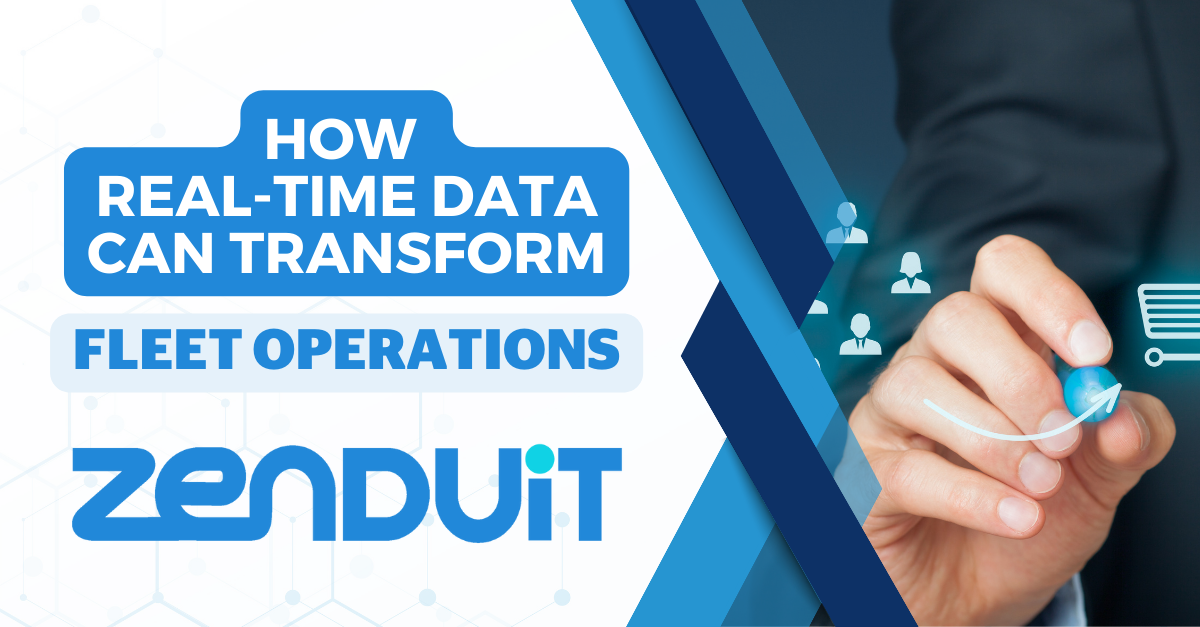Fleet operations stand out as a critical component In the ever-evolving landscape of modern industries, driving not just logistics and transportation, but also influencing sectors ranging from retail to utilities. These operations are the backbone of supply chains, ensuring timely delivery of goods and services across the globe. In fact, the Fleet Management market is projected to grow impressively, with a Compound Annual Growth Rate (CAGR) of 15.5%, escalating from USD 25.5 billion in 2022 to a staggering USD 52.4 billion by 2027. At the heart of this growth lies the transformative power of real-time data, and the insights they provide.
Real-time insights in fleet operations refer to the immediate analysis and utilization of data generated from various fleet activities. This data, captured through advanced technologies like GPS tracking and telematics, offers a live snapshot of numerous aspects, including vehicle locations, fuel usage, driver behavior, and vehicle performance. The real-time nature of this data is pivotal; it allows for swift decision-making and adjustments, far beyond what traditional, delayed reporting systems can offer.
In this post, we will explore the potential of immediate data to revolutionize fleet operations. By leveraging real-time data, organizations can achieve unprecedented levels of efficiency, enhance safety protocols, and significantly reduce operational costs. This change is not just incremental; it’s foundational, reshaping how fleet operations are conducted in a data-driven era.
The Evolution of Fleet Operations
The journey of fleet operations, from its rudimentary beginnings to the high-tech landscape of today, is a tale of constant innovation and adaptation.
Initially, fleet management was largely manual, relying on paper logs and direct communication to track vehicle movements and maintenance schedules. This era was characterized by significant inefficiencies, with delayed information often leading to suboptimal decision-making.
The digital revolution brought a seismic shift in how fleet operations were managed. The introduction of digital solutions, primarily GPS tracking systems, revolutionized the way fleets were monitored. This evolution marked the transition from passive to active management, where fleet managers could get real-time updates about vehicle locations and statuses.
The true game-changer, however, was the emergence of real-time data tracking. This technology not only provided live updates but also allowed for the integration of various data points, offering a comprehensive view of the entire fleet operation. This shift enabled more precise and timely decisions, dramatically improving efficiency and reducing costs.
Key Components of Real-Time Fleet Data Systems
Real-time fleet data systems are composed of several key components, each playing a vital role in ensuring the effectiveness and efficiency of fleet operations.
- GPS Tracking and Its Role in Real-Time Data: GPS tracking is the cornerstone of modern fleet management. It enables precise location tracking of vehicles, contributing to improved route planning, reduced fuel consumption, and timely deliveries. Real-time GPS data allows for immediate response to unexpected situations like traffic delays or vehicle breakdowns, optimizing fleet performance.
- Telematics: Integrating Vehicle Diagnostics with Data Analytics: Telematics is the fusion of telecommunications and informatics, applied specifically to vehicles. It encompasses the transmission of vehicle diagnostic data to fleet managers in real time. This data includes vehicle speed, engine status, fuel usage, and more, enabling a deeper understanding of vehicle performance and maintenance needs. By integrating this data with analytical tools, fleet managers can make informed decisions, predict potential issues, and schedule preventive maintenance, thereby reducing downtime and extending vehicle life.
- Communication Systems: Ensuring Continuous Flow of Information between Fleet Managers and Drivers: Effective communication systems are essential for the smooth operation of fleet activities. These systems facilitate the continuous flow of information between fleet managers and drivers, ensuring that critical updates, instructions, and feedback are communicated in real time. This communication is crucial for adapting to changing conditions, responding to emergencies, and maintaining overall operational harmony.
Together, these components form the backbone of real-time fleet data systems, allowing for enhanced control, foresight, and agility in fleet operations, leading to increased productivity, safety, and cost-efficiency.
Transformative Effects of Immediate Data on Fleet Operations
The integration of immediate data in fleet operations has led to significant transformations across various domains:
- Improved Operational Efficiency: Route Optimization and Scheduling – Immediate data facilitates dynamic route optimization, allowing fleet managers to adjust routes in real-time based on traffic conditions, weather, and other variables. This leads to more efficient scheduling, reducing idle times and enhancing overall operational productivity.
- Enhanced Safety: Real-time Monitoring of Vehicle Health and Driver Behavior – Continuous monitoring of vehicle health helps in identifying potential issues before they lead to breakdowns. Additionally, tracking driver behavior, such as speed and braking patterns, promotes safer driving practices, reducing the risk of accidents.
- Cost Reduction: Fuel Management and Predictive Maintenance – Real-time data aids in efficient fuel management by optimizing routes and reducing unnecessary idling. Predictive maintenance, based on vehicle diagnostics, prevents costly repairs and extends vehicle lifespan, contributing to significant cost savings.
- Environmental Impact: Reducing Carbon Footprint through Efficient Operations – By streamlining operations and reducing unnecessary fuel consumption, immediate data plays a critical role in lowering the carbon footprint of fleet operations. Efficient route planning and vehicle maintenance lead to reduced emissions, aligning fleet operations with environmental sustainability goals.
These transformative effects underscore the profound impact of real-time data in redefining fleet operations, making them more efficient, safe, cost-effective, and environmentally friendly.
Challenges and Considerations
While the adoption of real-time data in fleet operations brings numerous benefits, it also presents several challenges and considerations:
- Data Security and Privacy Concerns: As fleet systems collect and process large volumes of data, they become prime targets for cyberattacks. Ensuring robust data security measures and addressing privacy concerns, especially regarding driver information, are paramount to protect against data breaches and maintain trust.
- Complexity of Integrating New Technologies into Existing Systems: Integrating real-time data systems with existing fleet management solutions can be complex. It involves not only technical challenges but also aligning the new system with the organization’s processes and culture. Ensuring compatibility and minimizing disruptions are key challenges during this integration.
- Training and Adaptation: Preparing Staff for a Data-Driven Approach: The shift to a data-driven fleet management approach requires significant training and adaptation for staff. Employees need to be trained not only on how to use new technologies but also on how to interpret and act on the insights provided. This change management aspect is crucial for the successful implementation and maximization of the benefits of real-time data systems.
Addressing these challenges effectively is crucial for organizations to fully leverage the benefits of real-time data in fleet operations.
The Future of Fleet Operations with Real-Time Data
The future of fleet operations with real-time data is poised to be shaped by several emerging technologies and trends:
- Emerging Technologies and Trends in Fleet Data Analytics: Technologies like Artificial Intelligence (AI) and Machine Learning (ML) are set to revolutionize fleet data analytics. They enable more sophisticated data analysis, predictive modeling, and automation of complex tasks, leading to smarter and more proactive fleet management strategies.
- Predictions on How Real-Time Data Will Continue to Shape the Industry: The ongoing advancements in real-time data are expected to bring about more connected and automated fleets. This could lead to the development of self-diagnosing vehicles, more efficient electric fleet management, and even integration with smart city infrastructures.
- The Importance of Staying Ahead in Technology Adoption for Competitive Advantage: Staying at the forefront of technology adoption is crucial for companies seeking competitive advantage in the fleet industry. By embracing the latest trends and innovations in real-time data and analytics, organizations can not only improve their operational efficiency but also adapt more quickly to changing market dynamics and customer expectations.
Case Studies and Success Stories
The implementation of real-time data in fleet operations has led to significant improvements for various organizations. Here are detailed analyses of companies that have successfully integrated these systems:
- Microsoft – Azure Mobility Implementation at Redmond Campus: At Microsoft’s Redmond campus, a bustling hub with about 55,000 employees, the need for efficient fleet management was critical. The company implemented Microsoft’s own proprietary vehicle solution, to unify the management of their transportation fleet, which includes over 500 vehicles like trucks, passenger vans, and buses. This solution enabled data-driven decision-making to help Microsoft achieve its sustainability goals, including reaching carbon negative by 2030. The implementation of a fleet management solution provided real-time insights into fleet capacity, utilization, and maintenance needs. This integration significantly lowered downtime through predictive analytics and connected vehicles, drivers, and operations, boosting fuel efficiency and lowering emissions.
- Adapt Integrated Health Care – FleetCommander Adoption: Adapt Integrated Health Care, a nonprofit organization, faced challenges in fleet management with their fleet of 85 vehicles across southwest Oregon. They implemented a software solution that replaced an error-prone Excel spreadsheet system. This transition resulted in significant improvements in fleet operations, streamlining vehicle allocation processes and allowing self-reservation for drivers. The efficient management of their fleet has enabled the organization to support its mission more effectively and grow substantially. Without access to real-time data, Adapt estimated that they would need 55% more vehicles to sustain their operations.
- Basin Electric Power Cooperative – Transforming Fleet Management: Basin Electric Power Cooperative, managing a fleet of 1,200 units and a 30-vehicle motor pool, revolutionized their fleet with a management solution. Prior to this, their approach lacked standardization and effective data collection. With a new process in place, they automated many manual processes, providing 24/7 vehicle access, streamlined reservation processes, and centralized data collection. This led to a reduction of their fleet by 25 to 30%, saving approximately $100,000 in vehicle acquisition costs and achieving annual savings of $20,000.
- City of Stamford – Implementing Vehicle Sharing System: The City of Stamford, managing a fleet of 1,100 vehicles, recognized efficiency issues with its 80 passenger vehicles. By implementing a fleet management solution, they introduced vehicle sharing policies, leading to a smaller motor pool of 29 vehicles from the original 80. This reduction resulted in savings of $356,000 within two years, with projected five-year savings exceeding $1 million. Additionally, the integration with GPS tracking improved maintenance scheduling and enhanced driver accountability, transforming vehicle utilization and optimizing fleet operations.
These case studies demonstrate the measurable benefits of integrating real-time data into fleet operations, including improved efficiency, cost savings, and enhanced sustainability efforts. Each example offers unique insights and lessons learned, highlighting the importance of adapting to innovative fleet management solutions in today’s fast-paced environment.
Final Thoughts
Real-time data in fleet operations offers a myriad of benefits, including enhanced operational efficiency, improved safety, significant cost reductions, and a reduced environmental footprint. However, challenges like data security, technological integration, and staff training require careful navigation.
Industry leaders are encouraged to embrace these technologies to stay competitive and meet the evolving demands of the market. The ongoing evolution of fleet management, fueled by advancements in real-time data and analytics, presents an opportunity for continuous improvement and innovation.
If you are looking to explore the possibilities of real-time data in transforming your fleet operations, contact a ZenduiT consultant today, and discover how these technologies can be tailored to meet your specific business needs and propel your fleet operations into the future.










































